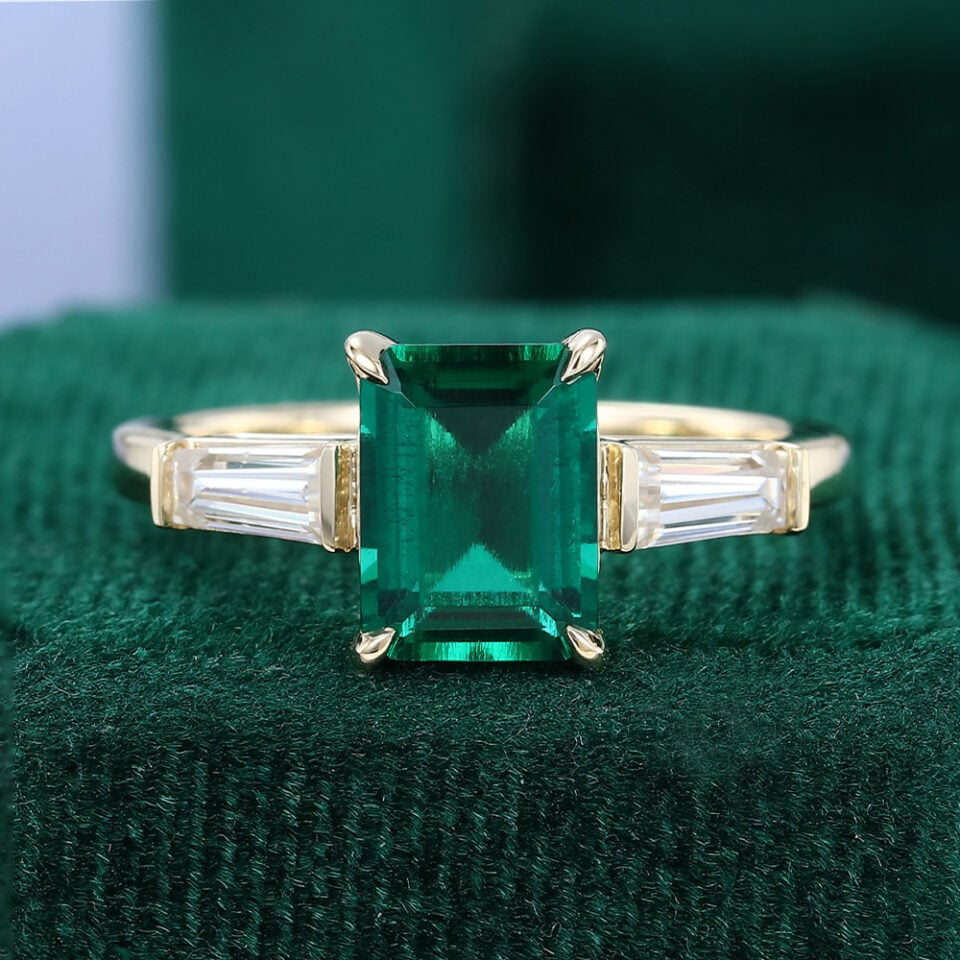The engagement ring trends of 2025 are about more than just outward sparkle – they’re about inner values shining through. Modern couples are increasingly asking:
- Where did this ring come from?
- Where is this gemstone sourced from?
- Was it handcrafted by someone who was treated fairly? Was the process ethical?
- What kind of impact did it leave behind?
As conversations around sustainability, traceability, and ethical sourcing become more common, so does the desire to make choices that reflect shared values – not just personal style.
Let’s take a look at the top ethical engagement ring trends shaping 2025.
1. Lab-Grown Gemstones Go Mainstream
Lab-grown diamonds, sapphires, emeralds, and a wide range of colorful gemstones are becoming the new classic. They’re no longer seen as just “budget-friendly alternatives”, but as smart, sustainable, and stunning mainstream options.
Lab-created diamonds and colored gemstones have evolved from “affordable substitutes” to powerful statements of intent.
- Same sparkle, durability, and beauty as mined gems.
- Significantly reduced environmental footprint.
- Fully traceable – no mystery mines, no guessing involved.
They’re not just easier on the wallet – they’re conflict-free and kinder to the planet. In fact, many buyers today choose lab-grown gemstones as a declaration of ethical sustainability, not just because they’re more affordable.
2. Recycled and Fairly Mined Metals
Beyond the gemstone, the metal that makes up the ring setting is just as essential. In 2025, more and more consumers are intentionally choosing:
- Recycled gold and platinum – to avoid the environmental damage caused by new mining.
- Fairly mined gold / Fairmined certified gold – to ensure small-scale miners are paid fairly and work in safe conditions.
Recycled and fairly mined metals have become standard for ethical and sustainable jewelry, not just a bonus feature.
3. Non-Traditional Gemstones on the Rise
While diamonds remain popular, many couples in 2025 are saying “yes” to color and uniqueness. More and more are choosing to break away from tradition and pick gemstones that reflect their personality, not just the conventional ones.
Think salt and pepper diamonds, morganite, aquamarine, moss agate, moonstone, opal… These stones bring color, meaning, and individuality to a proposal.
So, what do non-traditional gemstones have to do with ethical and sustainable engagement rings? Are they automatically ethical just because they’re different?
That’s a great question. The short answer – Yes, they often are. Here’s why:
- Many non-traditional gemstones can also be lab-grown.
- A lot of these gems are responsibly and transparently sourced from small-scale mines.
- Choosing smaller or less commercialized stones often supports local artisans instead of large global supply chains.
- Alternative gemstones allow couples to tell their own story, and typically have a smaller environmental impact than large-scale diamond mining.
4. Vintage Style & Low-Waste Designs
You might wonder, “Why is vintage considered a trend in ethical and sustainable engagement rings?” Actually, vintage is one of the most underrated eco-friendly design choices – and here’s why:
This isn’t just about vintage inspired designs. We’re talking about true vintage, such as repurposing heirloom gemstones or reworking old metals into a new “vintage” piece. It’s the purest form of reuse – a continuation of value, rather than creating something new from scratch.
This brings up an interesting point – the difference between vintage and antique jewelry. Antique jewelry typically refers to actual old pieces, often with 20+ years of history (though definitions can vary), made during a specific past era. Vintage jewelry, on the other hand, is inspired by antique styles but made with new materials that mimic those older looks.
5. Personalized Customization
Customization isn’t a new concept, but it adds emotional value to a ring. So why is it considered a trend in ethical and sustainable practices?
Personalized customization = less waste, less overconsumption.
Custom pieces are made specifically for one person. They’re not mass-produced on an assembly line. This made-to-order model avoids the problem of excess inventory being discarded, which helps reduce resource waste.
6. Transparency Becomes the Norm
Couples today want to know more than ever: Where did this come from? Who made it? Can I trace every part of it?
Brands that can answer these questions clearly and honestly are earning trust.
From sourcing to craftsmanship, MollyJewelryUS is committed to transparency in everything we do.
- All gemstones are 100% conflict-free and ethically sourced.
- All metals are recycled or certified sources.
- Every ring is handcrafted by skilled artisans in small batches. We pay each artisan above-average rates for their work.
To us, this isn’t a marketing angle – it’s simply the right way to work.
Final Thoughts: Choosing Conscious Love
The ethical engagement ring trends of 2025 reflect something deeper than fashion. They represent a growing desire to:
- Celebrate love without causing harm.
- Invest in long-lasting quality instead of fast, mass-produced sparkle.
- Speak from the heart – not just in carats, but in conscience.
If you’re exploring ways to make your engagement ring more meaningful – ethically, aesthetically, and emotionally – we’d love to help.
Explore our collection of ethical engagement rings or contact us to create a one-of-a-kind ring with real meaning.





